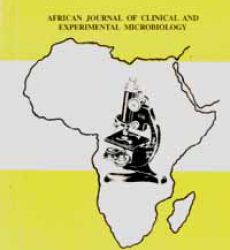Abstract
This study aims to observe the pattern of HIV infection in Irrua Hospital records of patients diagnosed and managed with HIV/AIDS between January 2001 and December 2004 were retrieved and subjected to statistical analysis. The results show that females have statistically significant lower age; more incidence of double infection with HIV1&2; and more clinical aneamia(low PCV values) compared to their male counterparts. Women are more likely to be HIV infected than men of similar ages for biological and cultural reasons. HIV also passes more easily from men to women than vice versa hence double infection is common. Anaemia is commoner in females because of incidence of marrow failure due to longer survival after HIV infection in women. Efforts should therefore be made to check the spread of this dreaded infection.
African Journal of Clinical and Experimental Microbiology Vol. 9 (1) 2008: pp. 33-37
Download full journal in PDF below
Pattern of HIVAIDS infection in Irrua a rural community in Nigeria

